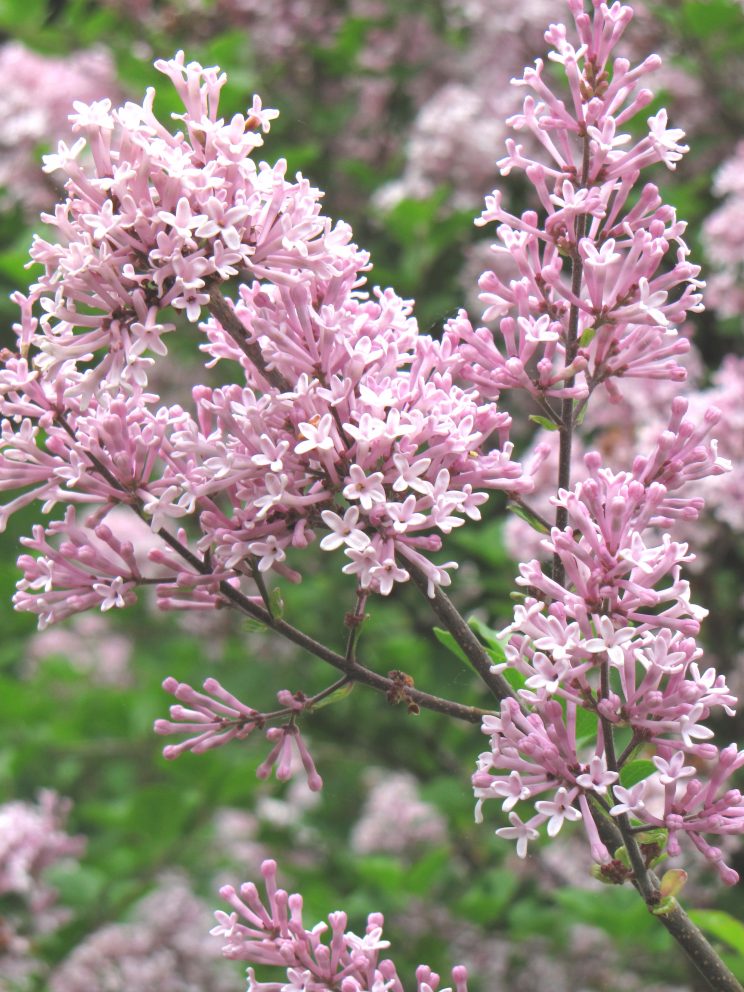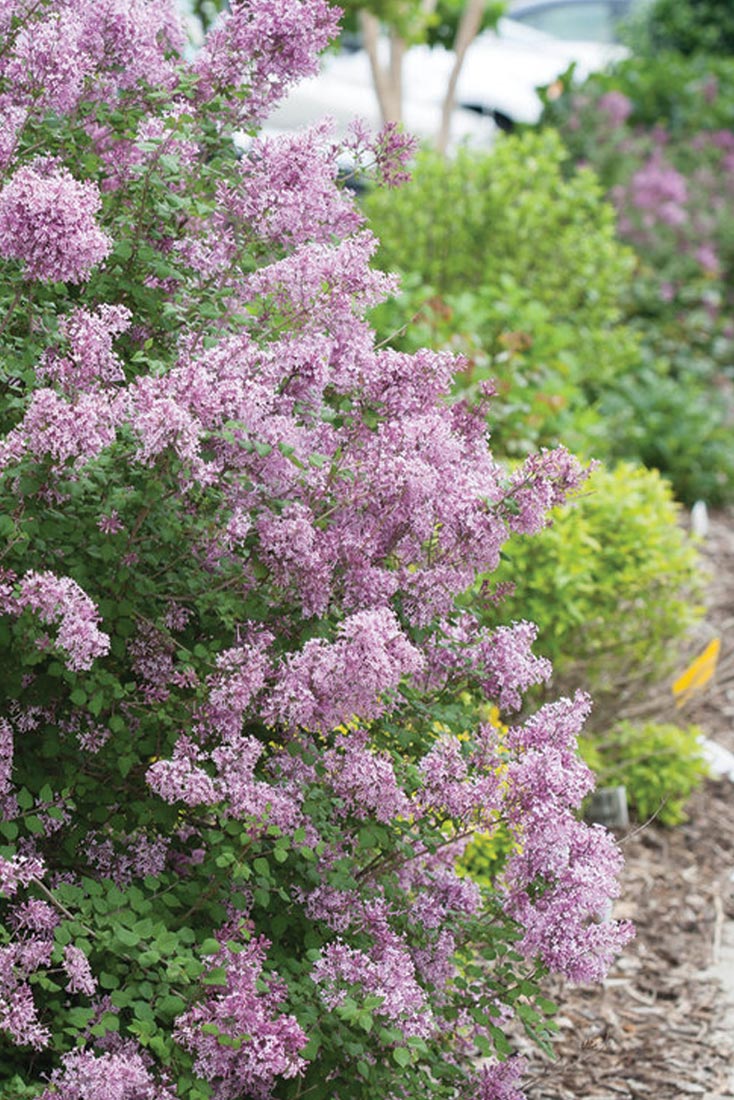How on earth did those small arborvitae I planted in front of the house get so huge?
Someone planted something that was small when it was first put down, or maybe it was you. But over the years, it has slowly grown into a huge monster.
Sometimes it’s hard to picture how big a bush or tree will get, even in a few years, let alone when it’s fully grown. Plant growers and breeders are aware of this issue, which is why there are more and more dwarf (or Latin names that include the words “nana” or “compacta”) varieties on the market. But if there is no dwarf variety available, you may find you need to seek out other options. Here are some smaller options for four of the most loved but often overgrown garden plants. We are talking about Arborvitae, Lilac, Birch, and Butterfly Bush.
With their sweetly fragrant blooms in shades of purple, pink and white, lilacs are a beloved spring-flowering shrub. But sometimes classic lilacs like Syringa vulgaris can outgrow their space or you want something a bit different. Luckily, many other plants share the familiar form and flowers of lilacs but with key distinctions. Keep reading to discover beautiful bushes that resemble lilacs for diverse landscapes.
Korean Lilac – Syringa meyeri
-
Compact shrub growing 4-5 feet tall and wide
-
Abundant lavender-pink blooms like small common lilac flowers
-
Neat dense bush with good powdery mildew resistance
-
Profuse flowering in late spring on prior year’s growth
Korean lilac, also known as Meyer lilac, is a smaller species well-suited to today’s gardens. It works nicely in borders, foundations and containers with full sun exposure.
Dwarf Korean Lilac – Syringa meyeri ‘Palibin’
-
Dwarf variety reaches just 4-5 feet tall and wide
-
Light pink buds open to sweetly fragrant pale purple flowers
-
Upright rounded form ideal for small spaces
-
Blooms spring through early summer; attractive green foliage
This compact Korean lilac cultivar fits anywhere you need a petite lilac. It’s ideal for rock gardens, edging beds and patio containers.
Bloomerang Lilac – Syringa ‘Bloomerang’
-
Compact lilacs reaching 3-4 feet tall and wide
-
Flowers resemble common lilac but rebloom from summer into fall
-
Available in purple and pink-purple color varieties
-
Neat, tidy habit; good for borders, foundations, pots
The Bloomerang series of lilacs give you the spring blooms you expect plus spectacular summer and fall reblooming. The dwarf shrubs work well in any small space.
Peking Lilac – Syringa pekinensis
-
Medium shrub growing 8-10 feet tall and wide
-
Fragrant white flower panicles in late spring
-
Exfoliating cinnamon-colored bark for winter interest
-
Upright vase shape; fast grower suitable for informal hedges
With clusters of white blooms and attractive exfoliating bark, Peking lilac offers a nice alternative to the ubiquitous purple varieties. Give it room to spread in borders and cottage gardens.
Miss Kim Lilac – Syringa patula ‘Miss Kim’
-
Compact shrub maturing at 6 feet tall and wide
-
Lavender flower buds open to fragrant pale lilac blooms
-
Dark green foliage turns burgundy-red in fall for seasonal interest
-
Upright form works well in perennial beds, borders and foundations
The deep wine fall foliage of Miss Kim lilac sets it apart from the ordinary. This petite, reblooming variety fits beautifully into any landscape.
Dwarf Korean Spice Lilac – Syringa meyeri ‘Dwarf Korean’
-
Compact form grows 4-5 feet tall and 6 feet wide
-
Extremely fragrant flowers open rich pink then fade to pale lavender
-
Dark green foliage is mildew resistant
Blooming in clouds of sweetly scented flowers in late spring, this fabulous dwarf offers big lilac fragrance in a petite package. It’s ideal for borders and mixed beds where fragrance can be appreciated up close.
So if you love lilacs but want smaller sizes or different bloom colors, check out these delightful alternatives. They’ll give you the beauty and charm of lilacs without overwhelming the landscape.
Other Shrubs that Mimic Lilacs
Beyond true lilac species and cultivars, some unrelated shrubs boast similar blossoms and growth habits:
Beautybush – Kolkwitzia amabilis
-
Arching branches bear abundant light pink bell-like blooms
-
Grows 8-10 feet tall and wide; suckering habit
-
Prefers full sun; tolerates most soils; drought resistant
False Spirea – Sorbaria sorbifolia
-
Large plumes of tiny white flowers like lilac panicles
-
Upright shrub growing 4-8 feet tall and 3-6 feet wide
-
Likes sun to part shade; spreads by suckers
Pink Weigela – Weigela florida ‘Pink Princess’
-
Clusters of tubular pink flowers; some varieties rebloom
-
Compact shrub maturing at 4-5 feet tall and wide
-
Full sun to light shade; attracts hummingbirds
While not exact lilac lookalikes, these flowering shrubs can provide a similar effect in the right location. Mix and match to extend the spring blooming season.
Using Lilac Lookalikes in the Landscape
Here are some tips for working these lilac lookalikes into your yard:
-
Use compact varieties like Meyer lilac and Bloomerang in borders, rock gardens and containers.
-
Plant reblooming types where you can enjoy their sporadic later flowers.
-
Feature fragrant species like Peking lilac and Korean Spice near patios or walkways.
-
Grow larger varieties like French and old-fashioned lilacs in backyards since they can spread widely.
-
Mix purple and white lilac lookalikes together for a play on the traditional combination.
-
Blend with other spring-blooming shrubs like viburnum, spirea and quince.
-
Underplant with bulbs and perennials like peonies, iris and poppies.
With so many choices, you can find a lilac lookalike tailored to any size or style garden. Work them into existing beds or display them in pots on porches and patios. Soon you’ll forget you don’t have real lilacs!
FAQs About Lilac Lookalike Bushes
Home gardeners often have lots of questions when seeking lilac alternatives. Here are some commonly asked questions:
Are there dwarf lilac bushes?
Yes, dwarf options like Meyer lilac ‘Palibin’, Bloomerang, Miss Kim and Dwarf Korean Spice lilac mature at just 3-6 feet, perfect for small spaces.
What shrub looks like a lilac but blooms yellow?
Spirea, beautybush and Scotch broom have lilac-like blooms in yellow or gold shades. Some weigela and forsythia varieties also produce yellow flowers.
Is there a white lilac bush?
Syringa pekinensis and some cultivars of S. vulgaris produce white lilac blooms. Korean Spice bush also has creamy white flowers.
Do any shrubs smell like lilacs?
Most alternatives share the distinctive lilac fragrance. Beautybush, Korean Spice bush, Bloomerang and Meyer lilac have noticeably fragrant flowers.
Lilac Landscaping Ideas – Smaller Lilacs for more variety and color?
Need a ladder to get to your lilacs? Here are some dwarf lilacs that won’t get too big. The common lilac, Syringa vulgaris, grows to be 12 to 20 feet tall and 8 to 15 feet wide when it’s fully grown. A good alternative is S. meyeri ‘Palibin’, a compact 4-5 foot cultivar of Korean lilac. Or Also, The Bloomerang lilacs (S. x ‘Bloomerang’, ‘Bloomerang Purple’) were developed using S. meyerii as a parent and are a great, short 3-4 foot alternative.

Syringa meyeri ‘Palibin’ has pale pink, fragrant flowers that bloom profusely in late spring. As a bonus, its foliage is quite resistant to powdery mildew. Full sun, USDA Zones 4-7.

Bloomerang lilacs (Syringa x ‘Bloomerang’, ‘Bloomerang Purple‘) are a great 3 to 4 foot alternative to the larger and more mildew-prone common lilac, S. vulgaris. Another plus is their sporadic re-bloom throughout the summer and into fall. Full sun, USDA Zones 4-7.
What looks like an arborvitae (but offers something better)?
Juniper is my personal favorite arborvitae alternative. Juniperus virginiana (or eastern red cedar) is also native and provides a varied texture. It doesn’t grow as quickly and does best where it’s dry (juniper turns brown when it gets too wet). I also love Juniperus scopulorum ‘Wichita Blue.’ This tree isn’t native to New England, but it is native to the rocky mountain area where I grew up. I love this tree for how tough it is and how beautiful its blue branches are.
Three Great Lilacs for Your Garden: Miss Kim, Bloomerang and Dwarf Korean
- The Ultimate Guide to Growing Strawberries in Raised Beds - August 8, 2025
- No-Dig Garden Beds: The Easiest Way to Grow a Beautiful Garden - August 6, 2025
- How to Protect and Preserve Wood for Raised Garden Beds - August 6, 2025
